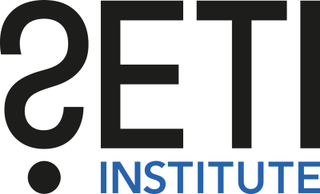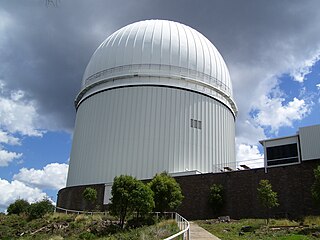
The search for extraterrestrial intelligence (SETI) is a collective term for scientific searches for intelligent extraterrestrial life, for example, monitoring electromagnetic radiation for signs of transmissions from civilizations on other planets.

Frank Donald Drake is an American astronomer and astrophysicist. He is involved in the search for extraterrestrial intelligence, including the founding of SETI, mounting the first observational attempts at detecting extraterrestrial communications in 1960 in Project Ozma, developing the Drake equation, and as the creator of the Arecibo Message, a digital encoding of an astronomical and biological description of the Earth and its lifeforms for transmission into the cosmos.

The Terrestrial Planet Finder (TPF) was a proposed project by NASA to construct a system of space telescopes for detecting extrasolar terrestrial planets. TPF was postponed several times and finally cancelled in 2011. There were two telescope systems under consideration, the TPF-I, which had several small telescopes, and TPF-C, which used one large telescope.

The Lick Observatory is an astronomical observatory owned and operated by the University of California. It is on the summit of Mount Hamilton, in the Diablo Range just east of San Jose, California, United States. The observatory is managed by the University of California Observatories, with headquarters on the University of California, Santa Cruz campus, where its scientific staff moved in the mid-1960s. It is named after James Lick.

Michel Gustave Édouard Mayor is a Swiss astrophysicist and professor emeritus at the University of Geneva's Department of Astronomy. He formally retired in 2007, but remains active as a researcher at the Observatory of Geneva. He is co-laureate of the 2019 Nobel Prize in Physics along with Jim Peebles and Didier Queloz, and the winner of the 2010 Viktor Ambartsumian International Prize and the 2015 Kyoto Prize.

The SETI Institute is a not-for-profit research organization incorporated in 1984 whose mission is to explore, understand, and explain the origin and nature of life in the universe, and to apply the knowledge gained to inspire and guide present and future generations. It aims for discovery and for sharing knowledge as scientific ambassadors to the public, the press, and the government. SETI stands for the "search for extraterrestrial intelligence". The Institute consists of three primary centers: The Carl Sagan Center, devoted to the study of life in the universe, the Center for Education, focused on astronomy, astrobiology and space science for students and educators, and the Center for Public Outreach, producing "Big Picture Science," the Institute's general science radio show and podcast, and "SETI Talks" weekly colloquium series.

The Australian Astronomical Observatory (AAO), formerly the Anglo-Australian Observatory, was an optical and near-infrared astronomy observatory with its headquarters in North Ryde in suburban Sydney, Australia. Originally funded jointly by the United Kingdom and Australian governments, it was managed wholly by Australia's Department of Industry, Innovation, Science, Research and Tertiary Education. The AAO operated the 3.9-metre Anglo-Australian Telescope (AAT) and 1.2-metre UK Schmidt Telescope (UKST) at Siding Spring Observatory, located near the town of Coonabarabran, Australia.

The High Accuracy Radial Velocity Planet Searcher (HARPS) is a high-precision echelle planet-finding spectrograph installed in 2002 on the ESO's 3.6m telescope at La Silla Observatory in Chile. The first light was achieved in February 2003. HARPS has discovered over 130 exoplanets to date, with the first one in 2004, making it the most successful planet finder behind the Kepler space observatory. It is a second-generation radial-velocity spectrograph, based on experience with the ELODIE and CORALIE instruments.

Leuschner Observatory, originally called the Students' Observatory, is an observatory jointly operated by the University of California, Berkeley and San Francisco State University. The observatory was built in 1886 on the Berkeley campus. For many years, it was directed by Armin Otto Leuschner, for whom the observatory was renamed in 1951. In 1965, it was relocated to its present home in Lafayette, California, approximately 10 miles (16 km) east of the Berkeley campus. In 2012, the physics and astronomy department of San Francisco State University became a partner.

The James Lick Telescope is a refracting telescope built in 1888. It has a lens 36 inches (91 cm) in diameter- a major achievement in its day. The instrument remains in operation and public viewing is allowed on a limited basis. Also called the "Great Lick Refractor" or simply "Lick Refractor", it was the largest refracting telescope in the world until 1897 and now ranks third, after the 40-inch refractor at the Yerkes Observatory and the Swedish 1-m Solar Telescope. The telescope is located at the University of California's Lick Observatory atop Mount Hamilton at an elevation of 4,209 feet (1,283 m) above sea level. The instrument is housed inside a dome that is powered by hydraulic systems that raise and lower the floor, rotate the dome and drive the clock mechanism to track the Earth's rotation. The original hydraulic arrangement still operates today, with the exception that the original wind-powered pumps that once filled the reservoirs have been replaced with electric pumps. James Lick is entombed below the floor of the observing room of the telescope.

The C. Donald Shane telescope is a 120-inch (3.05-meter) reflecting telescope located at the Lick Observatory in San Jose, California. It was named after astronomer C. Donald Shane in 1978, who led the effort to acquire the necessary funds from the California Legislature, and who then oversaw the telescope's construction. It is the largest and most powerful telescope at the Lick Observatory, and was the second-largest optical telescope in the world when it was commissioned in 1959.

The Carnegie telescope is a twin 20-inch (510 mm) refractor telescope located at Lick Observatory in California, United States. The double telescope's construction began in the 1930s with a grant from the Carnegie institution, although it was not completed until the 1960s when a second lens was added. The telescope is not designed for visual observation, rather it has two lenses used for taking photographs for a specific wavelength recorded on a film emulsion. It was used for photographic sky surveys in the late 20th century, which were successfully completed.

The Crossley telescope is a 36-inch (910 mm) reflecting telescope located at Lick Observatory in the U.S. state of California. It was used between 1895 to 2010, and was donated to the observatory by Edward Crossley, its namesake.

The Mount Abu InfraRed Observatory (MIRO) is located near the town Mount Abu in the state of Rajasthan, India. The observatory is at an altitude of 1680 metres and is adjacent to Guru Shikhar, highest peak of the Aravalli Range. The 1.2 m infrared telescope at It is the first major facility in India specifically designed for ground-based, infrared observations of celestial objects. Further the low amount of precipitable water vapour at Guru Shikhar makes it a good site for the infrared telescope observations. The site has been found to be good for astronomical observations.

Steven Scott Vogt is an American astronomer of German descent whose main interest is the search for extrasolar planets.
The Lick–Carnegie Exoplanet Survey (LCES) is a search for exoplanets using the Keck I optical telescope of the W. M. Keck Observatory in Hawaii. The survey is sponsored by NASA and the National Science Foundation. The survey comprises a decade of observations. The survey is led by Steven Vogt, professor of astronomy and astrophysics at University of California at Santa Cruz, and R. Paul Butler of the Carnegie Institution.

Breakthrough Listen is a project to search for intelligent extraterrestrial communications in the Universe. With $100 million in funding and thousands of hours of dedicated telescope time on state-of-the-art facilities, it is the most comprehensive search for alien communications to date. The project began in January 2016, and is expected to continue for 10 years. It is a component of Yuri Milner's Breakthrough Initiatives program. The science program for Breakthrough Listen is based at Berkeley SETI Research Center, located in the Astronomy Department at the University of California, Berkeley.
MINERVA-Australis is a dedicated exoplanet observatory, operated by the University of Southern Queensland, in Queensland, Australia. The facility is located at USQ's Mount Kent Observatory, and saw first light in quarter two 2018. Commissioning of the facility was completed in mid-2019, and the facility was officially launched on 23 July 2019.

The Berkeley SETI Research Center (BSRC) conducts experiments searching for optical and electromagnetic transmissions from intelligent extraterrestrial civilizations. The center is based at the University of California, Berkeley.

The NIROSETI is an astronomical program to search for artificial signals in the optical (visible) and near infrared (NIR) wavebands of the electromagnetic spectrum. It is the first dedicated near-infrared SETI experiment. The instrument was created by a collaboration of scientists from the University of California, San Diego, Berkeley SETI Research Center at the University of California, Berkeley, University of Toronto, and the SETI Institute. It uses the Anna Nickel 1-m telescope at the Lick Observatory, situated on the summit of Mount Hamilton, east of San Jose, California, USA. The instrument was commissioned on 15 March 2015 and has been operated for more than 150 nights.




















